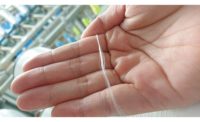Openness in knit fabric
Knitting machine gauge and yarn size control how open the glove textile will be. For 13-gauge knits, for example, using a 210 denier yarn, there is perhaps a 30-40 percent open area in the textile. The percentage of openness in the knit affects how the glove feels and how much stretch it has. Most users would agree that more open knits result in cooler, more comfortable and dexterous gloves. The downside of more open knits is that it is much harder to create high cut level gloves with small yarns with open space.
The knit needs to work with the dip
Most users like the grip and durability that palm-coated knit gloves offer. Knit gloves with high levels of openness have an additional benefit for dipping and coating. With high open area, the dip coating can penetrate the textile and encapsulate the yarn on the palm of the glove. The dip can be nitrile, polyurethane or NR latex. When the dip can penetrate the knit, the coating has the best possible attachment to the textile.
For comfortable gloves with good dexterity, the coating and the knit must be thin, no more than 2-4 mm thickness in total. For this type of thin coating layer to be durable, it must be well supported by the textile. The rubber in the coating does not have good tear strength. The yarn in the glove provides the reinforcement to prevent premature failure of the coating layer.
When the knit works with the dip you can build a thin, comfortable, durable glove.
Fibers
A common mistake in glove selection is picking the wrong fiber type. As you will find from the descriptions below, fibers are not all created equal.
Polyester is perhaps the most widely used synthetic fiber. It is low in cost and available in many sizes and types. Moderate tensile strength and low cut performance limit the protection from this material used alone. Polyester yarn in its textured form has good abrasion for its price point. Chemical resistance is broad, however polyester is a moderate temperature fiber with a burn and drip risk. This material is useful as a blending fiber for controlling the cost of a composite yarn.
Nylon is the second most widely used synthetic fiber. Nylon has moderate tensile strength and low cut. Nylon has really standout abrasion resistance, which makes it very useful in gloves. The military has used nylon in combination with cotton for Battle Dress Uniforms (BDUs) and other garments for many years. Like polyester, nylon is an excellent choice for glove components. It is slightly more expensive than polyester but higher in durability. Nylon has moderate temperature resistance and a burn and drip risk if used by itself. Chemical resistance is lower than polyester.
Para-Aramid fiber is aromatic nylon. The fiber is strong but small filament size limits its performance for light knit gloves. High tensile strength with small filaments make this a better puncture material than a cut product. Cut level 4 and 5 gloves need a high density knit fiber cover. These high cover knits are bulky and not very comfortable. Para-aramids are high temp materials and have excellent flame performance. But they have iffy chemical performance; acids and chlorine bleach are big trouble for these materials. One last caution, Para-Aramid fibers are not good for abrasion. Gloves made from these fibers should have a coating or a cover glove.
Ultra High Molecular Weight Polyethylene (UHMWPE) is significantly stronger than the Para-Aramids. They offer good cut performance and excellent chemical resistance to most common compounds. These materials can only handle about 220ºF and start to fail at just slightly higher temperatures. Because UHMWPE is polyethylene, it is very low friction. This makes UHMWPE a poor choice for puncture resistance. Also, UHMWPE will burn and has a bad melt drip issue.
Liquid Crystal Polyester (LCP) material has tensile strength between UHMWPE and Para-Aramid. LCP is a large denier per filament fiber and has very good cut. Because LCP is Aromatic Polyester it is also a high temp fiber. LCP fiber is resistant to most industrial chemistry and has some flame resistance. LCP is better all around in abrasion than either Para-Aramid or UHMWPE. Bear in mind that abrasion and durability in gloves is a complex topic and this review is a summary. The combination of large filament, tensile, chemical resistance, high temp and abrasion make LCP a strong competitor. It provides great combination performance in cut and puncture applications.
Fiberglass is just glass, and it is fragile. Fiberglass does not do well in abrasion or in flex. The damaged surface of fiberglass yarn has sharp ends of broken filament exposed, and this filament can cause skin irritation. However fiberglass is very hard when compared to all the organic fibers we have talked about. Fiberglass is harder than most cutting tools. The glass fiber breaks down the cutting edge of the threat and gives good cut resistance. As long as the fiberglass has a protective cover of one of the other fibers on the list, it is a tough, high-cut fiber. Fiberglass has great thermal resistance and will not burn. Chemical resistance is uneven.
Stainless steel fiber, like fiberglass, is a specialty item used in combination with one of the other fibers. This fiber has all the properties of steel: hardness, toughness and stiffness. It also has good thermal and chemical resistance. However, as this material is used in a blend, these properties are only as useful as the total performance of the blended yarn. To address the stiffness of steel, these fibers are a low denier per filament and this limits the performance to some degree.


